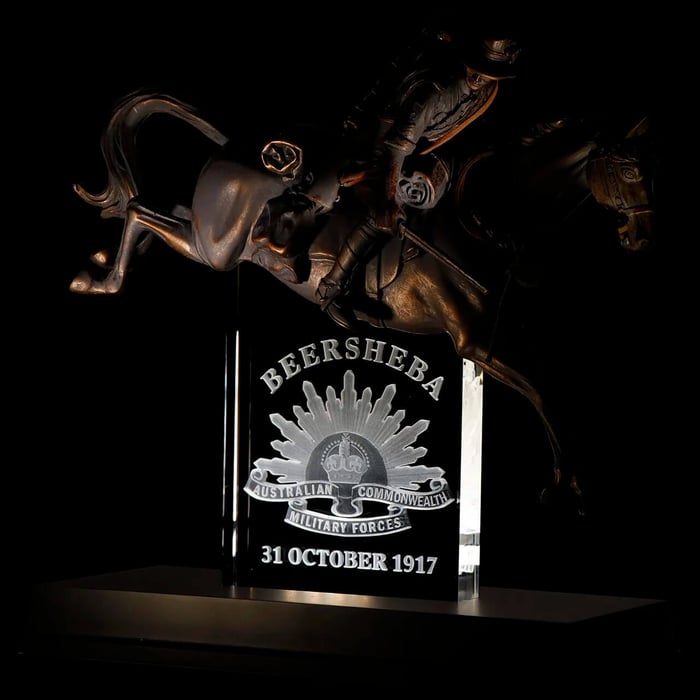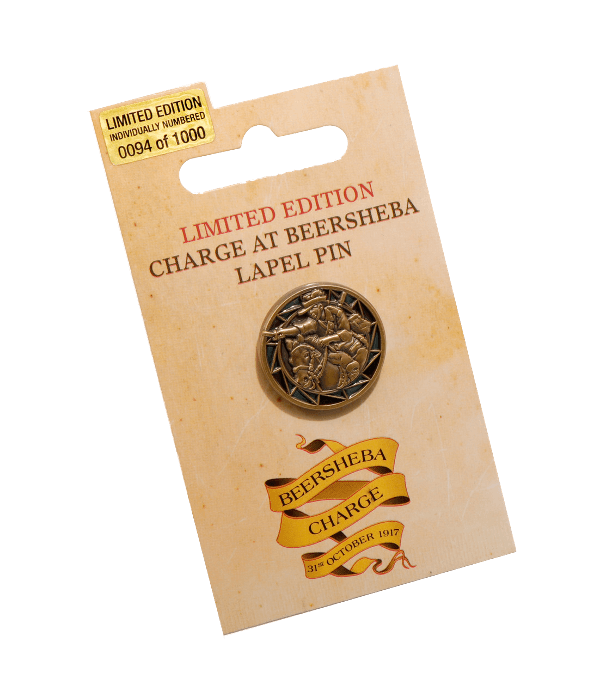
Beersheba's Biggest Day Yet
At dawn on Wednesday 31 October 1917 Australian and British forces launched an attack on the heavily fortified town of Beersheba in the desert of the Middle East. The town stood at the eastern end of the 35-mile Turkish defensive line that stretched to Gaza on the Mediterranean coast. To reach Palestine and Jerusalem Gaza must fall. Two attempts directly on Gaza had failed. The intention now was to venture deep into the desert and turn the line at Beersheba.
The British commander of the Egyptian Expeditionary Force, General Sir Edmund Allenby, insisted the town be taken in a day. His force of 40,000 Allied troops and thousands of mounts would need a supply of water quickly. The town contained the only viable wells for miles.
Behind the extending trenches set forward of the town; the barbed wire and walls at Beersheba were 1,000 Turkish riflemen, machine guns, German artillery and two aircraft. In every direction, the defending forces had commanding lines of fire over open ground. They also had the water.
Throughout the day the Allies pounded the defences but by mid-afternoon, while some outer defences were captured, neither the British infantry to the southwest nor the mounted division’s further east, had penetrated into Beersheba itself.
Battle of Beersheba Limited Edition Medallion Set
More so than any others in the battle, the mounted troops desperately needed water for their mounts, most of which had not had water for 48 hours. If the attack became bogged down the defenders would have time to destroy the wells before being overrun. At 3.30pm Lieutenant General Harry Chauvel, the Australian commander of the Desert Mounted Corps, turned to Brigadier General William Grant, commanding the 4th Light Horse Brigade and ordered a mounted attack on the town’s southern defences where recognisance photographs showed the trenches were not protected by barbed wire. But this time the troopers were to stay in the saddle and charge the enemy directly.
By 4.50pm the 4th Brigade assembled behind rising ground four miles south-east of Beersheba – the 4th Light Horse Regiment on the right, the 12th on the left and the 11th in reserve.
Instead of cavalry sabres, the 800 Australians carried bayonets, which by luck, just days before, they had been instructed to sharpen to a point.
The 4th and 12th regiments moved off at a trot and then a canter. Turkish gunners, aware of the Light Horse tactics, were ordered to hold fire until the troopers dismounted. But the horsemen advanced. Within two miles of the town the defenders opened fire but the horsemen, now in full gallop, moved too fast for the riflemen and gunners, whose sights were set too high. Machine gunners firing into the horsemen were quickly silenced by British artillery.
At full gallop, with bayonets in hand, the horsemen jumped first the front trenches and then the main. As they cleared a line troopers leapt from their saddles to attack the Turks with rifle and bayonet. Others sped on to do the same at the rear trenches, while others still galloped into the town itself.
Limited Edition Charge at Beersheba Lapel Pin
Read: Bold and Loyal: The Australian Light Horse
Turkish demolition teams set charges in the wells but the speed and ferocity of the attack caught them by surprise and the German officer in command of the operation was captured. Most of the wells were left intact.
The 4th and 12th Light Horse casualties were thirty-one killed and thirty-six wounded.
The charge of the 4th Light Horse Brigade delivered Beersheba and turned the Gaza-Beersheba line. A week later Gaza itself was taken and on 9 December 1917 Allies marched into Jerusalem. Lest we forget.
Commemorate This Triumph
Our Charge at Beersheba collection remembers this historic charge. This landmark collection of limited edition figurines celebrates the Australian Light Horse – the men; their trusted Waler re-mounts, and the charge that changed history. Explore this collection here.
















